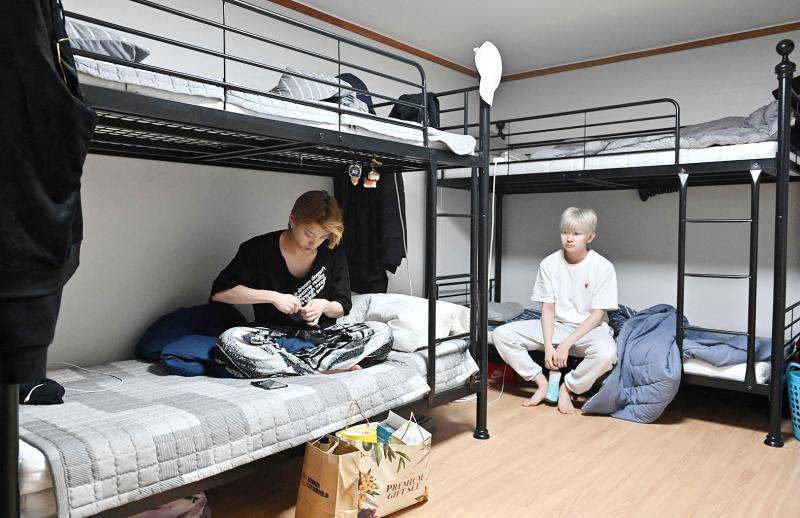Thirty teenagers, thousands of hours of training, dozens of shattered dreams: it all comes to a head next week when the Blitzers will be launched into the cut-throat K-pop market, hoping to become the next BTS.
An all-male septet — like the musical phenomenon that topped the US Billboard charts last year — their three years of training are being distilled into three minutes of music and dancing that will determine whether they are a hit, or just another nowhere band.
The routine, always intense, is punishing in the weeks running up to their debut: gym sessions, singing lessons, promotional shoots, and around 10 hours of dance practice into the early morning. The program leaves them less than five hours sleep a night in bunk-beds in their shared Seoul house — the empty berths tombs for the hopes of those expelled after failing to make the cut.

Photo: AFP
In a dedicated, mirror-lined rehearsal studio, the seven survivors stood poised for the opening bars of their first single, Breathe Again, outnumbered by managers, trainers and choreographers.
The moment it came over the speakers they launched into high-energy lockstep moves, spinning each other around with military precision.
“Though I want to hold your hands I can’t come near you/Because I’m stuck unable to move,” sang 17-year-old lead singer Cho Woo-ju as he jumped off a human staircase formed by his bandmates.

Photo: AFP
As the song reached its climax they came together in a line-up, simultaneously throwing trademark K-pop poses.
But the response was underwhelming.
“It was just a warm up for you guys, right?” said a dance instructor. “Let’s do it for real now.” “Yes!” the boys responded with a unanimous shout.

Photo: AFP
“We practice our dance moves until we synchronize them perfectly,” said backup singer Jang Jun-ho.
‘ONLY A COUPLE SURVIVE’
K-pop is the latest and biggest instance of the so-called Korean Wave, as the South’s popular culture gains overseas recognition — epitomized by the global success of boy band BTS.
The phenomenon earns billions of dollars for the world’s 12th largest economy and scores of groups are assembled and launched each year by record labels trying to capture a slice of the pie.
The Blitzers were put together by Wuzo Entertainment, a nascent Seoul management agency.
The firm has invested around one billion won (US$900,000) in the band — its first — and is effectively betting its existence on their success.
The potential returns are huge — the agency behind BTS, Big Hit Entertainment, since renamed Hybe, floated on the Korean stock exchange last year and now has a market capitalization of more than US$7 billion.
But the odds are stacked against the Blitzers, whose six-track debut mini-album will be released on Wednesday.
“Every year more than 50 idol groups launch into the market,” said Kim Jin-hyung, the label’s co-chief executive. “Only a couple of them survive.
“If Blitzers succeed the company succeeds,” he said. “If they fail, it’s almost certain we’ll have to shut down our business.”
‘I FELT A SENSE OF GUILT’
The Blitzers are all aged 17 to 19 and were mostly recruited while still in school, some of them initially training part-time after class.
A rigorous testing process whittled them down, until 12 of them moved into the shared house for the final stage, with the seven group members chosen in November.
Even the winners were left with mixed feelings. Leader Choi Jin-hwa, 19, said that altogether he saw around 20 of his fellow trainees dismissed, but he “never got used to it.”
“Regardless of how long they had been with us, they had all practiced all day long with me ever since joining,” he said. “Even though I had done nothing wrong, I felt a sense of guilt.”
The discipline is relentless, with Wuzo determining when they get up, when and what they eat, when they wear make-up and when they go to bed.
Weight control is constant.
“We ban them from eating night time snacks,” said manager Oh Chang-seok, who lives with the band, combining the roles of caregiver and enforcer.
“It’s inevitable,” he explained. “They have to be ready at any time” if a promotional opportunity arises.
The K-pop industry is accused of consuming young hopefuls with only a tiny minority surviving to stardom, with former Nine Muses idol Ryu Sera last year likening it to a “factory-like mass-production system.”
Wuzo’s Kim rejects such criticism as “one-sided.”
“We as a company give trainees an opportunity to pursue and realize their dreams and they give us an opportunity to grow as a company,” he said. “We are all in this together.”
And manager Oh is realistic about cast-off former trainees.
“We can’t help those who were given an opportunity for self improvement but couldn’t keep up with the others,” he said. “We need to present the public with the best ones.”

May 26 to June 1 When the Qing Dynasty first took control over many parts of Taiwan in 1684, it roughly continued the Kingdom of Tungning’s administrative borders (see below), setting up one prefecture and three counties. The actual area of control covered today’s Chiayi, Tainan and Kaohsiung. The administrative center was in Taiwan Prefecture, in today’s Tainan. But as Han settlement expanded and due to rebellions and other international incidents, the administrative units became more complex. By the time Taiwan became a province of the Qing in 1887, there were three prefectures, eleven counties, three subprefectures and one directly-administered prefecture, with

President William Lai (賴清德) yesterday delivered an address marking the first anniversary of his presidency. In the speech, Lai affirmed Taiwan’s global role in technology, trade and security. He announced economic and national security initiatives, and emphasized democratic values and cross-party cooperation. The following is the full text of his speech: Yesterday, outside of Beida Elementary School in New Taipei City’s Sanxia District (三峽), there was a major traffic accident that, sadly, claimed several lives and resulted in multiple injuries. The Executive Yuan immediately formed a task force, and last night I personally visited the victims in hospital. Central government agencies and the

Among Thailand’s Chinese Nationalist Party (KMT) villages, a certain rivalry exists between Arunothai, the largest of these villages, and Mae Salong, which is currently the most prosperous. Historically, the rivalry stems from a split in KMT military factions in the early 1960s, which divided command and opium territories after Chiang Kai-shek (蔣介石) cut off open support in 1961 due to international pressure (see part two, “The KMT opium lords of the Golden Triangle,” on May 20). But today this rivalry manifests as a different kind of split, with Arunothai leading a pro-China faction and Mae Salong staunchly aligned to Taiwan.

As with most of northern Thailand’s Chinese Nationalist Party (KMT) settlements, the village of Arunothai was only given a Thai name once the Thai government began in the 1970s to assert control over the border region and initiate a decades-long process of political integration. The village’s original name, bestowed by its Yunnanese founders when they first settled the valley in the late 1960s, was a Chinese name, Dagudi (大谷地), which literally translates as “a place for threshing rice.” At that time, these village founders did not know how permanent their settlement would be. Most of Arunothai’s first generation were soldiers